Turning Points in Christian History 2
Chris Knepp
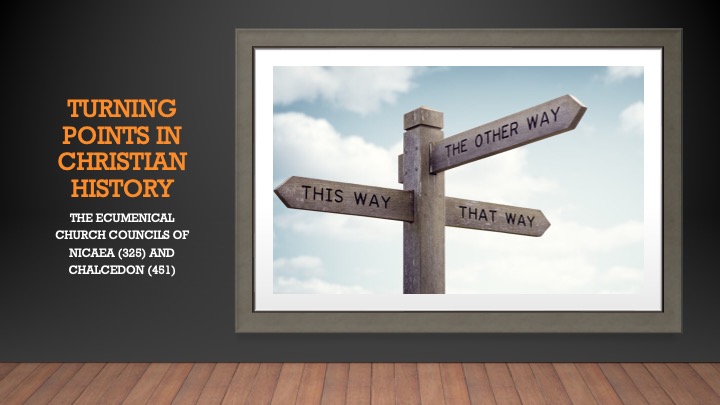
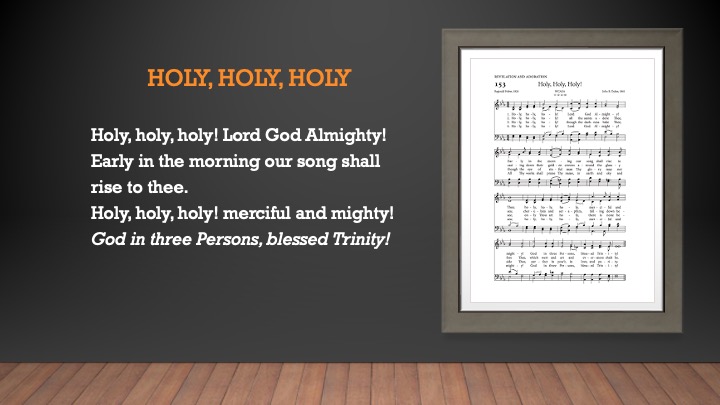
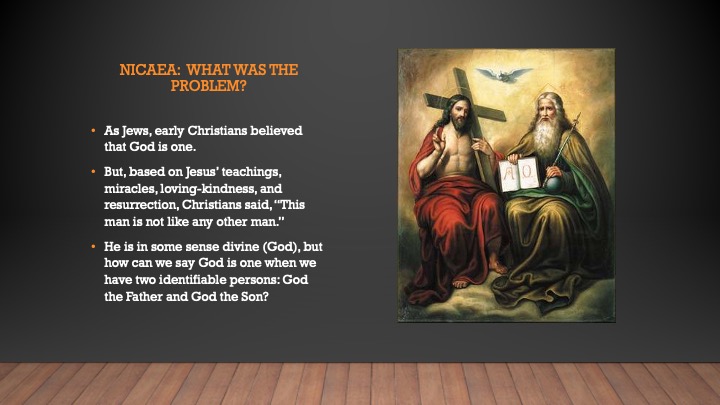
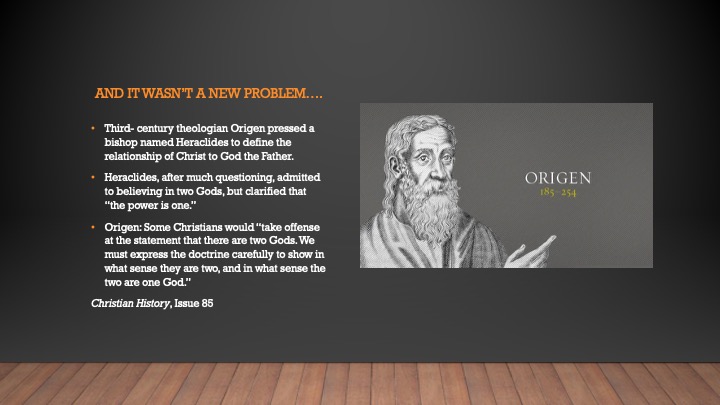
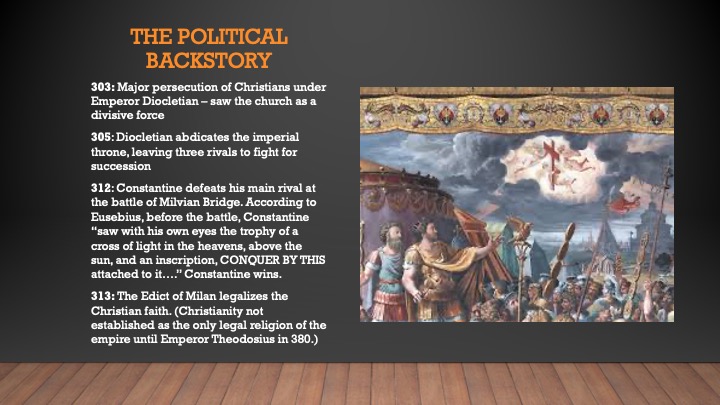
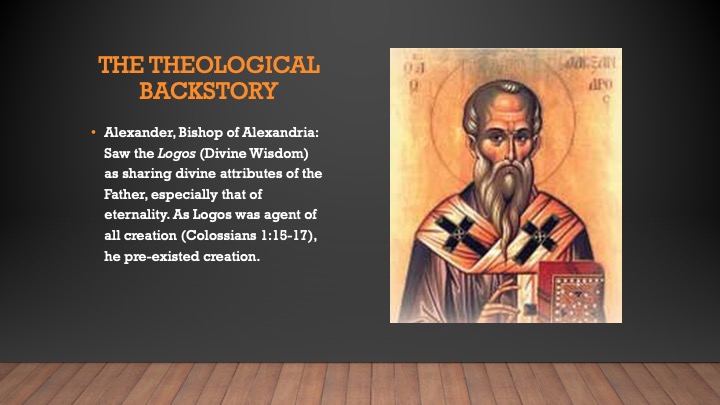
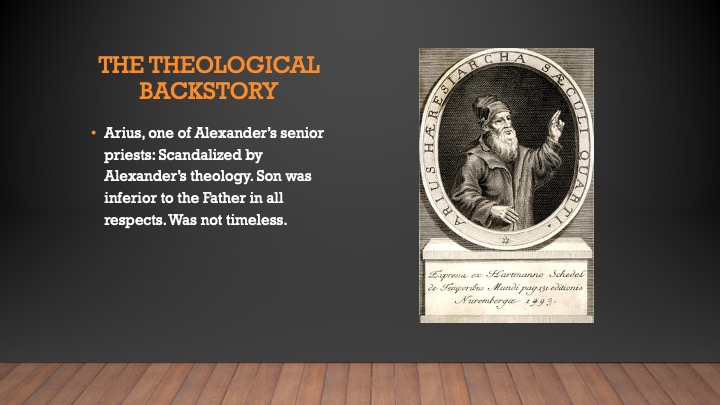
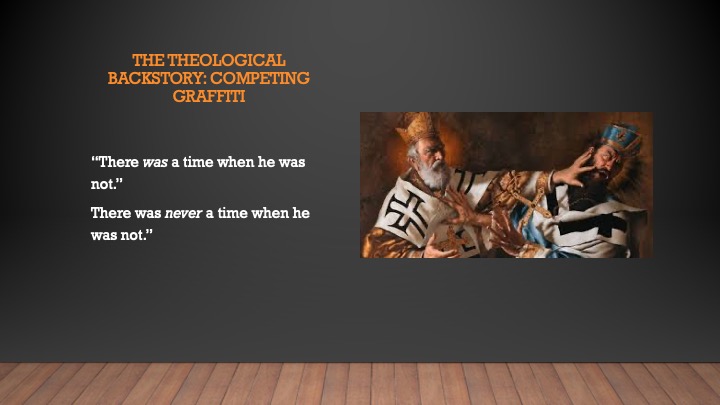
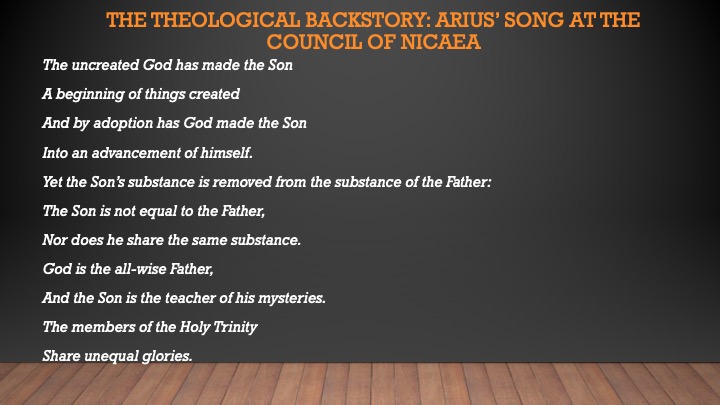
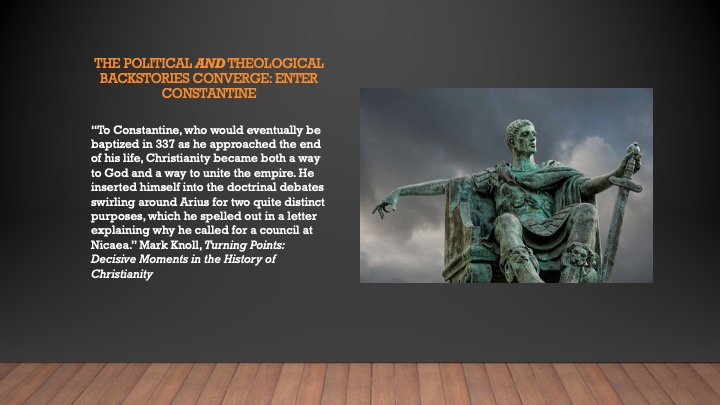
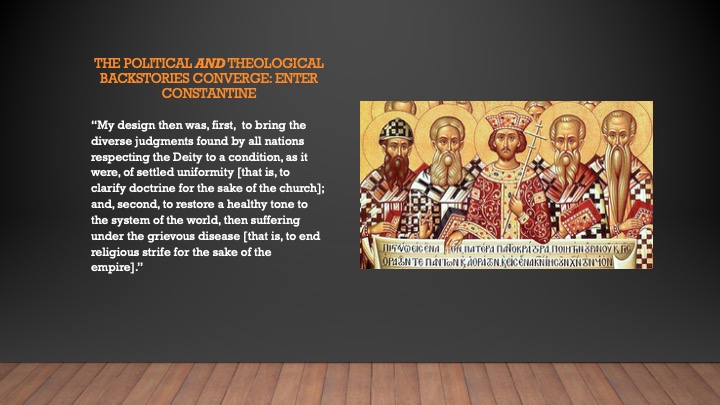
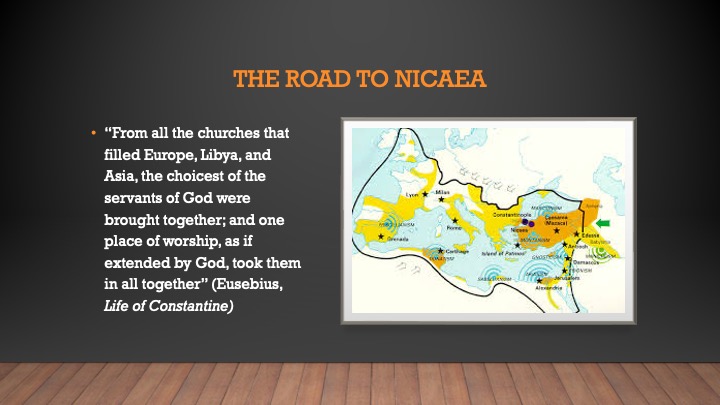
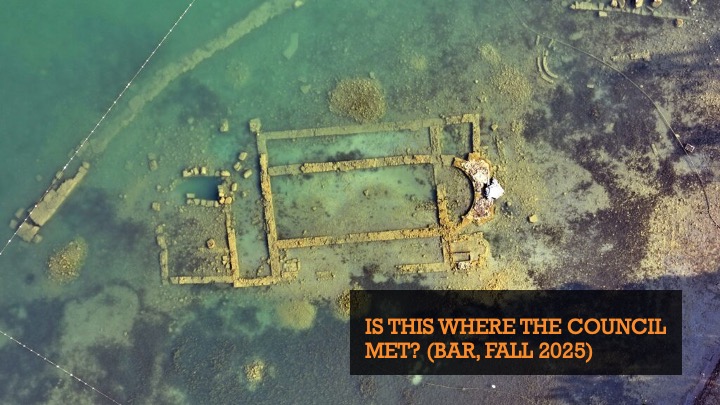
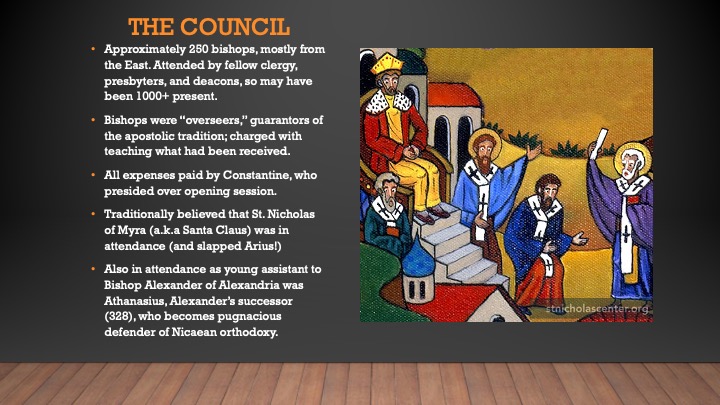
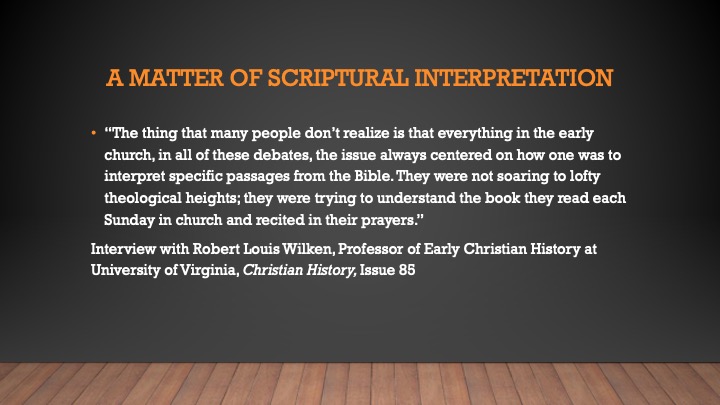
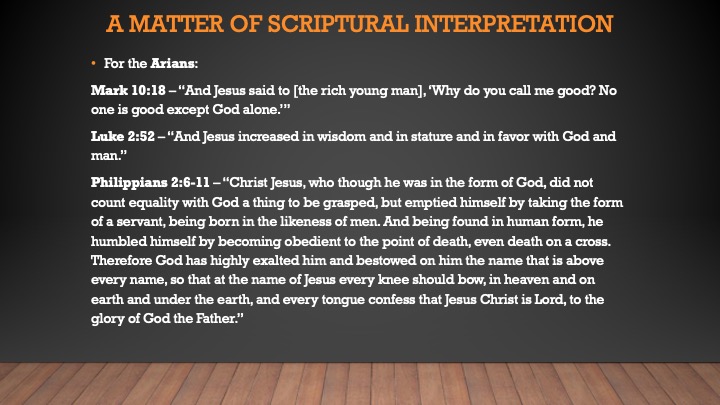
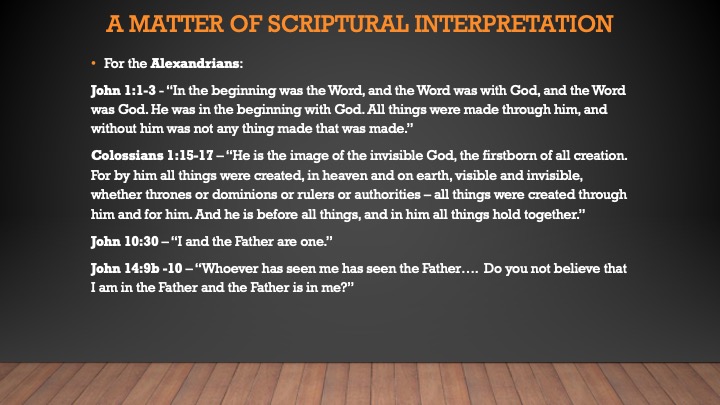
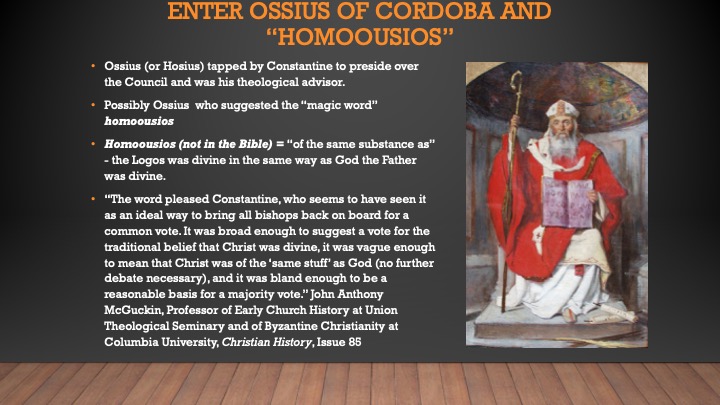
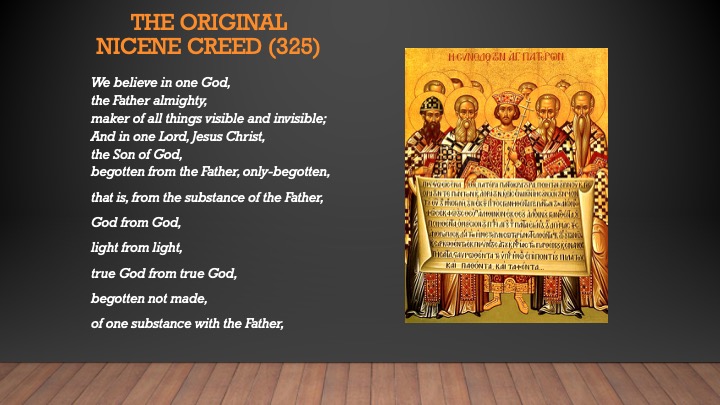
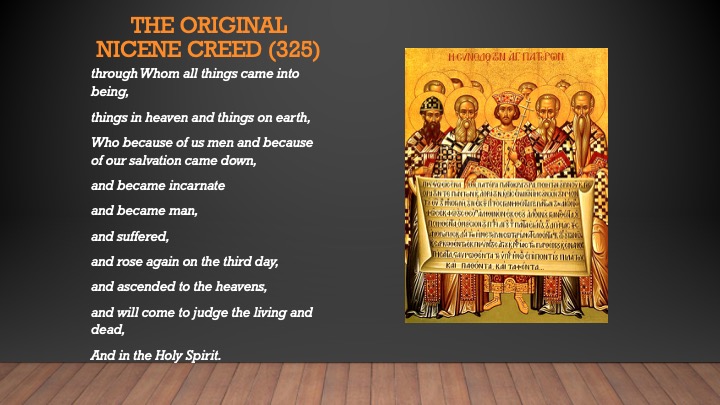
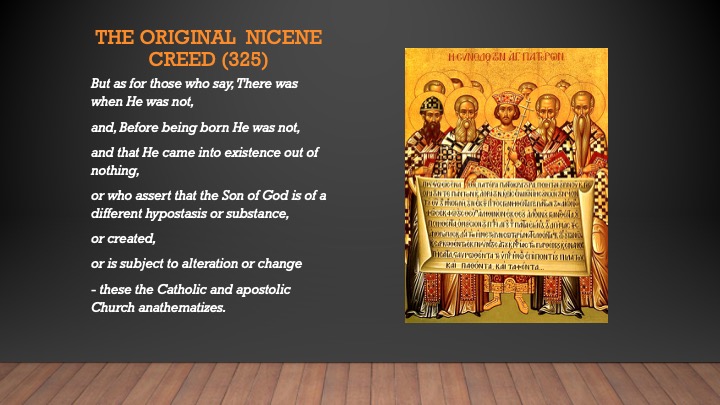
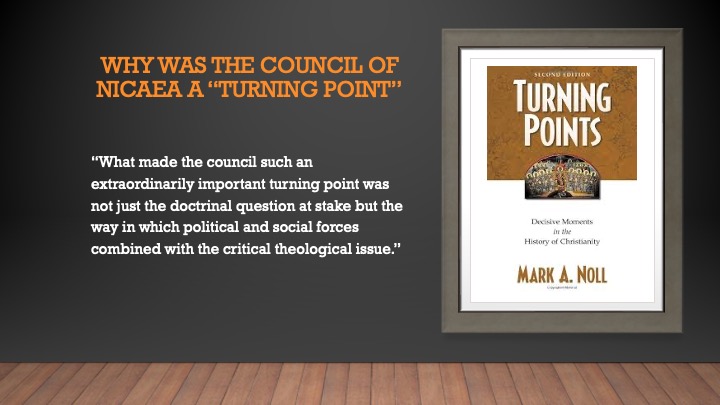
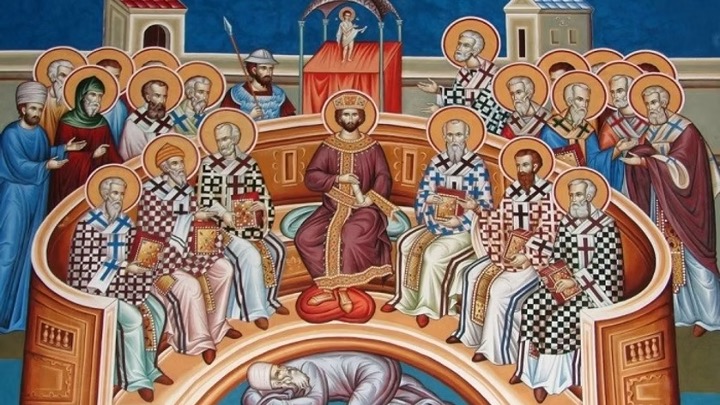
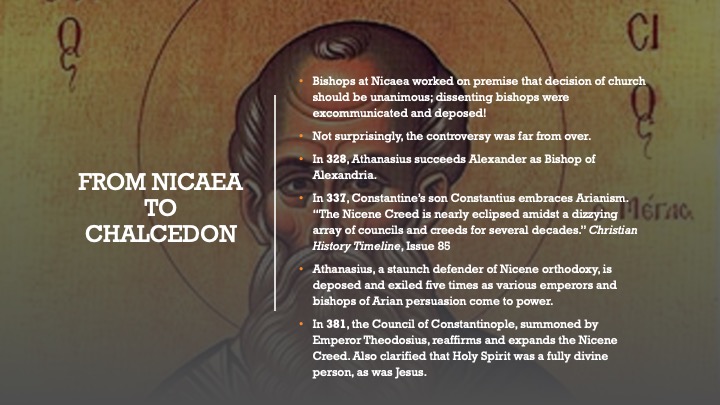
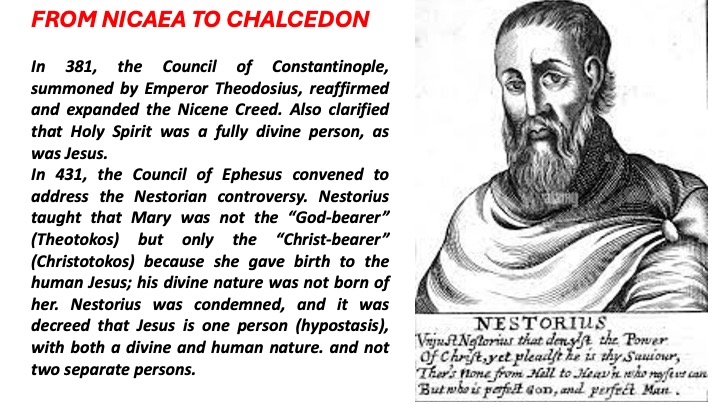
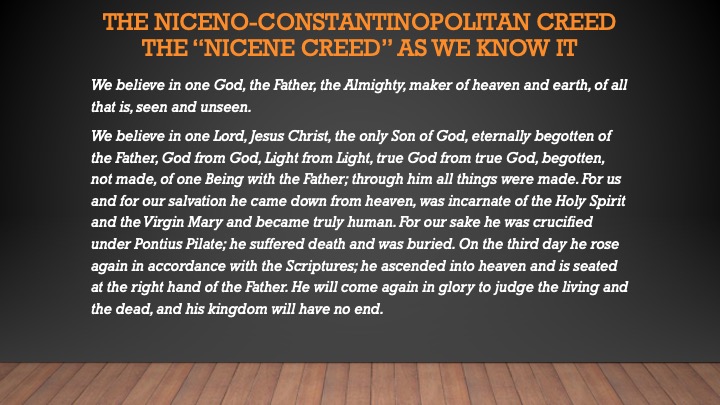
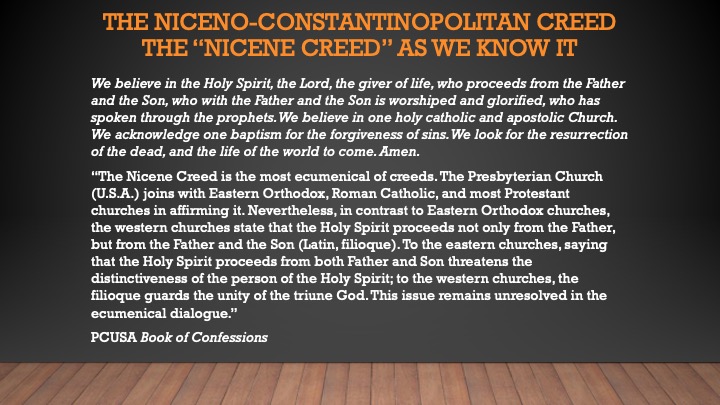
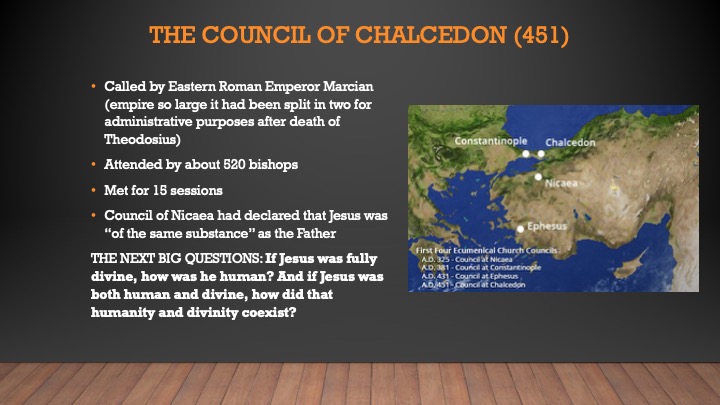
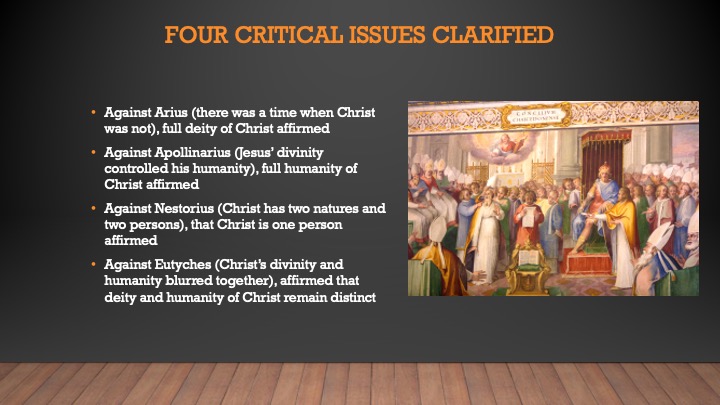
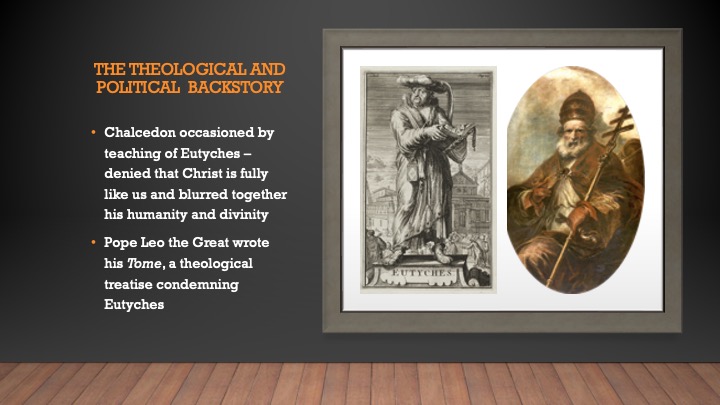
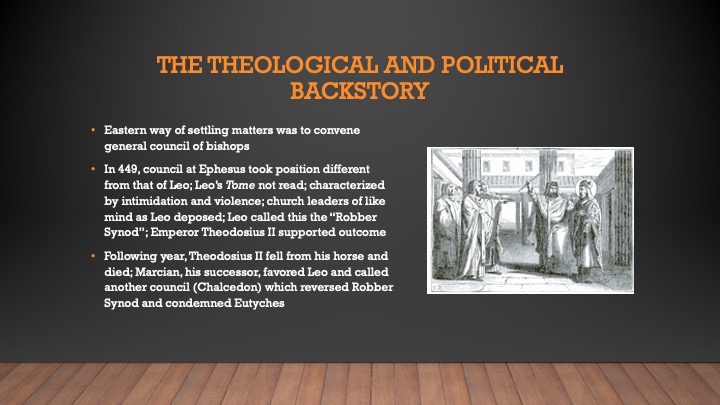
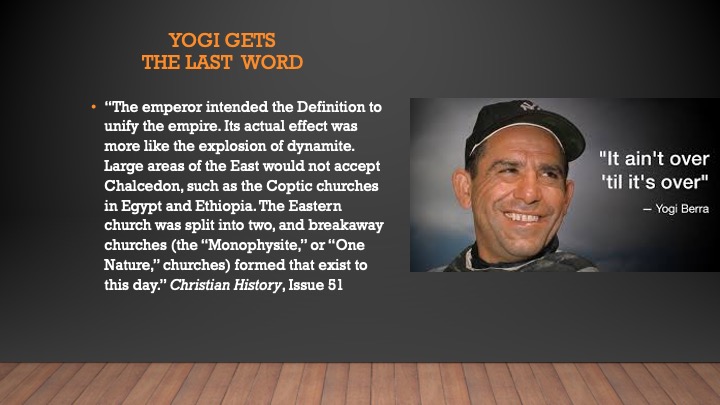
Turning Points in Christian History 2
Links
<< Home >> << Turning Points Menu >>
Turning Points in Christian History - The Text
Turning Points in Church History 2 – the Text
Turning Points in Christian History
The Ecumenical Church Councils of Nicaea (325) and Chalcedon (451)
Holy, holy, holy
Holy, holy, holy! Lord God Almighty!
Early in the morning our song shall rise to thee.
Holy, holy, holy! merciful and mighty!
God in three Persons, blessed Trinity!
NICAEA: What was the problem?
• As Jews, early Christians believed that God is one.
• But, based on Jesus’ teachings, miracles, loving-kindness, and resurrection, Christians said, “This man is not like any other man.”
• He is in some sense divine (God), but how can we say God is one when we have two identifiable persons: God the Father and God the Son?
• and it wasn’t a new problem….
• Third- century theologian Origen pressed a bishop named Heraclides to define the relationship of Christ to God the Father.
• Heraclides, after much questioning, admitted to believing in two Gods, but clarified that “the power is one.”
• Origen: Some Christians would “take offense at the statement that there are two Gods. We must express the doctrine carefully to show in what sense they are two, and in what sense the two are one God.”
• Christian History, Issue 85
The Political Backstory
303: Major persecution of Christians under Emperor Diocletian – saw the church as a divisive force
305: Diocletian abdicates the imperial throne, leaving three rivals to fight for succession
312: Constantine defeats his main rival at the battle of Milvian Bridge. According to Eusebius, before the battle, Constantine “saw with his own eyes the trophy of a cross of light in the heavens, above the sun, and an inscription, CONQUER BY THIS attached to it….” Constantine wins.
313: The Edict of Milan legalizes the Christian faith. (Christianity not established as the only legal religion of the empire until Emperor Theodosius in 380.)
• Alexander, Bishop of Alexandria: Saw the Logos (Divine Wisdom) as sharing divine attributes of the Father, especially that of eternality. As Logos was agent of all creation (Colossians 1:15-17), he pre-existed creation.
• Arius, one of Alexander’s senior priests: Scandalized by Alexander’s theology. Son was inferior to the Father in all respects. Was not timeless.
The Theological Backstory: Competing Graffiti
“There was a time when he was not.”
There was never a time when he was not.”
The Theological Backstory: ARIUS’ SONG AT The COUNCIL of NICAEA
The uncreated God has made the Son
A beginning of things created
And by adoption has God made the Son
Into an advancement of himself.
Yet the Son’s substance is removed from the substance of the Father:
The Son is not equal to the Father,
Nor does he share the same substance.
God is the all-wise Father,
And the Son is the teacher of his mysteries.
The members of the Holy Trinity
Share unequal glories.
The political and theological backstories converge: enter Constantine
“To Constantine, who would eventually be baptized in 337 as he approached the end of his life, Christianity became both a way to God and a way to unite the empire. He inserted himself into the doctrinal debates swirling around Arius for two quite distinct purposes, which he spelled out in a letter explaining why he called for a council at Nicaea.” Mark Knoll, Turning Points: Decisive Moments in the History of Christianity
The political and theological backstories converge: enter Constantine
“My design then was, first, to bring the diverse judgments found by all nations respecting the Deity to a condition, as it were, of settled uniformity [that is, to clarify doctrine for the sake of the church]; and, second, to restore a healthy tone to the system of the world, then suffering under the grievous disease [that is, to end religious strife for the sake of the empire].”
The road to Nicaea
• “From all the churches that filled Europe, Libya, and Asia, the choicest of the servants of God were brought together; and one place of worship, as if extended by God, took them in all together” (Eusebius, Life of Constantine)
The Council
• Approximately 250 bishops, mostly from the East. Attended by fellow clergy, presbyters, and deacons, so may have been 1000+ present.
• Bishops were “overseers,” guarantors of the apostolic tradition; charged with teaching what had been received.
• All expenses paid by Constantine, who presided over opening session.
• Traditionally believed that St. Nicholas of Myra (a.k.a Santa Claus) was in attendance (and slapped Arius!)
• Also in attendance as young assistant to Bishop Alexander of Alexandria was Athanasius, Alexander’s successor (328), who becomes pugnacious defender of Nicaean orthodoxy.
The Agenda
• Jesus’ divinity
• Universal date for Easter
• What to do with Christians who had apostatized during persecution
• Marriage restrictions for clergy and other matters of church order
• The canon of scripture was NOT on the agenda (aBrown)
• Ran from May 25-July 25, A.D. 325
A Matter of Scriptural Interpretation
• “The thing that many people don’t realize is that everything in the early church, in all of these debates, the issue always centered on how one was to interpret specific passages from the Bible. They were not soaring to lofty theological heights; they were trying to understand the book they read each Sunday in church and recited in their prayers.”
Interview with Robert Louis Wilken, Professor of Early Christian History at University of Virginia, Christian History, Issue 85
• For the Arians:
Mark 10:18 – “And Jesus said to [the rich young man], ‘Why do you call me good? No one is good except God alone.’”
Luke 2:52 – “And Jesus increased in wisdom and in stature and in favor with God and man.”
Philippians 2:6-11 – “Christ Jesus, who though he was in the form of God, did not count equality with God a thing to be grasped, but emptied himself by taking the form of a servant, being born in the likeness of men. And being found in human form, he humbled himself by becoming obedient to the point of death, even death on a cross. Therefore God has highly exalted him and bestowed on him the name that is above every name, so that at the name of Jesus every knee should bow, in heaven and on earth and under the earth, and every tongue confess that Jesus Christ is Lord, to the glory of God the Father.”
• For the Alexandrians:
John 1:1-3 - “In the beginning was the Word, and the Word was with God, and the Word was God. He was in the beginning with God. All things were made through him, and without him was not any thing made that was made.”
Colossians 1:15-17 – “He is the image of the invisible God, the firstborn of all creation. For by him all things were created, in heaven and on earth, visible and invisible, whether thrones or dominions or rulers or authorities – all things were created through him and for him. And he is before all things, and in him all things hold together.”
John 10:30 – “I and the Father are one.”
John 14:9b -10 – “Whoever has seen me has seen the Father…. Do you not believe that I am in the Father and the Father is in me?”
Enter ossius of cordoba and “homoousios”
• Ossius (or Hosius) tapped by Constantine to preside over the Council and was his theological advisor.
• Possibly Ossius who suggested the “magic word” homoousios
• Homoousios (not in the Bible) = “of the same substance as” - the Logos was divine in the same way as God the Father was divine.
• “The word pleased Constantine, who seems to have seen it as an ideal way to bring all bishops back on board for a common vote. It was broad enough to suggest a vote for the traditional belief that Christ was divine, it was vague enough to mean that Christ was of the ‘same stuff’ as God (no further debate necessary), and it was bland enough to be a reasonable basis for a majority vote.” John Anthony McGuckin, Professor of Early Church History at Union Theological Seminary and of Byzantine Christianity at Columbia University, Christian History, Issue 85
The Original Nicene Creed (325)
We believe in one God,
the Father almighty,
maker of all things visible and invisible;
And in one Lord, Jesus Christ,
the Son of God,
begotten from the Father, only-begotten,
that is, from the substance of the Father,
God from God,
light from light,
true God from true God,
begotten not made,
of one substance with the Father,
through Whom all things came into being,
things in heaven and things on earth,
Who because of us men and because of our salvation came down,
and became incarnate
and became man,
and suffered,
and rose again on the third day,
and ascended to the heavens,
and will come to judge the living and dead,
And in the Holy Spirit.
But as for those who say, There was when He was not,
and, Before being born He was not,
and that He came into existence out of nothing,
or who assert that the Son of God is of a different hypostasis or substance,
or created,
or is subject to alteration or change
- these the Catholic and apostolic Church anathematizes.
Why was the council of Nicaea a “Turning point”
“What made the council such an extraordinarily important turning point was not just the doctrinal question at stake but the way in which political and social forces combined with the critical theological issue.”
From Nicaea to Chalcedon
• Bishops at Nicaea worked on premise that decision of church should be unanimous; dissenting bishops were excommunicated and deposed!
• Not surprisingly, the controversy was far from over.
• In 328, Athanasius succeeds Alexander as Bishop of Alexandria.
• In 337, Constantine’s son Constantius embraces Arianism. “The Nicene Creed is nearly eclipsed amidst a dizzying array of councils and creeds for several decades.” Christian History Timeline, Issue 85
• Athanasius, a staunch defender of Nicene orthodoxy, is deposed and exiled five times as various emperors and bishops of Arian persuasion come to power.
• In 381, the Council of Constantinople, summoned by Emperor Theodosius, reaffirms and expands the Nicene Creed. Also clarified that Holy Spirit was a fully divine person, as was Jesus.
In 381, the Council of Constantinople, summoned by Emperor Theodosius, reaffirmed and expanded the Nicene Creed. Also clarified that Holy Spirit was a fully divine person, as was Jesus.
In 431, the Council of Ephesus convened to address the Nestorian controversy. Nestorius taught that Mary was not the “God-bearer” (Theotokos) but only the “Christ-bearer” (Christotokos) because she gave birth to the human Jesus; his divine nature was not born of her. Nestorius was condemned, and it was decreed that Jesus is one person (hypostasis), with both a divine and human nature. and not two separate persons.
The Niceno-Constantinopolitan Creed - The “Nicene Creed” as we know it
We believe in one God, the Father, the Almighty, maker of heaven and earth, of all that is, seen and unseen.
We believe in one Lord, Jesus Christ, the only Son of God, eternally begotten of the Father, God from God, Light from Light, true God from true God, begotten, not made, of one Being with the Father; through him all things were made. For us and for our salvation he came down from heaven, was incarnate of the Holy Spirit and the Virgin Mary and became truly human. For our sake he was crucified under Pontius Pilate; he suffered death and was buried. On the third day he rose again in accordance with the Scriptures; he ascended into heaven and is seated at the right hand of the Father. He will come again in glory to judge the living and the dead, and his kingdom will have no end.
We believe in the Holy Spirit, the Lord, the giver of life, who proceeds from the Father and the Son, who with the Father and the Son is worshiped and glorified, who has spoken through the prophets. We believe in one holy catholic and apostolic Church. We acknowledge one baptism for the forgiveness of sins. We look for the resurrection of the dead, and the life of the world to come. Amen.
“The Nicene Creed is the most ecumenical of creeds. The Presbyterian Church (U.S.A.) joins with Eastern Orthodox, Roman Catholic, and most Protestant churches in affirming it. Nevertheless, in contrast to Eastern Orthodox churches, the western churches state that the Holy Spirit proceeds not only from the Father, but from the Father and the Son (Latin, filioque). To the eastern churches, saying that the Holy Spirit came from both Father and Son threatens the distinctiveness of the person of the Holy Spirit; to the western churches, the filioque guards the unity of the triune God. This issue remains unresolved in the ecumenical dialogue.”
PCUSA Book of Confessions
The Council of Chalcedon (451)
• Called by Eastern Roman Emperor Marcian (empire so large it had been split in two for administrative purposes after death of Theodosius)
• Attended by about 520 bishops
• Met for 15 sessions
• Council of Nicaea had declared that Jesus was “of the same substance” as the Father
THE NEXT BIG QUESTIONS: If Jesus was fully divine, how was he human? And if Jesus was both human and divine, how did that humanity and divinity coexist?
The Theological and Political Backstory
• Eastern way of settling matters was to convene general council of bishops
• In 449, council at Ephesus took position different from that of Leo; Leo’s Tome not read; characterized by intimidation and violence; church leaders of like mind as Leo deposed; Leo called this the “Robber Synod”; Emperor Theodosius II supported outcome
• Following year, Theodosius II fell from his horse and died; Marcian, his successor, favored Leo and called another council (Chalcedon) which reversed Robber Synod and condemned Eutyches
The Chalcedonian Definition
Affirmed that Christ is:
• “truly God”
• “perfect in Godhead”
• “begotten of the Father before the ages”
• Also “truly man”
• “perfect in manhood”
• Born of the Virgin Mary
• Deity and humanity “not parted or divided into two persons”, rather “one person and one being”
• Deity and humanity not blurred together
Christ is “made known in two natures [which exist] without confusion, without change, without division, without separation.”
But Yogi Gets the Last Word
“It Ain’t Over Till It’s Over”
• “The emperor intended the Definition to unify the empire. Its actual effect was more like the explosion of dynamite. Large areas of the East would not accept Chalcedon, such as the Coptic churches in Egypt and Ethiopia. The Eastern church was split into two, and breakaway churches (the “Monophysite,” or “One Nature,” churches) formed that exist to this day.” Christian History, Issue 51